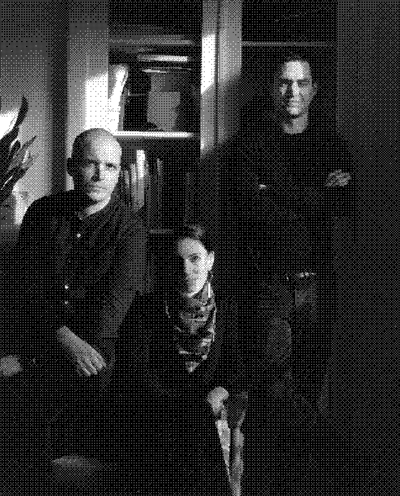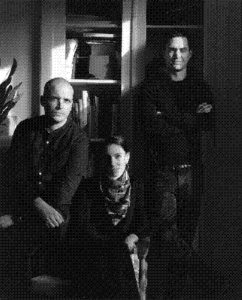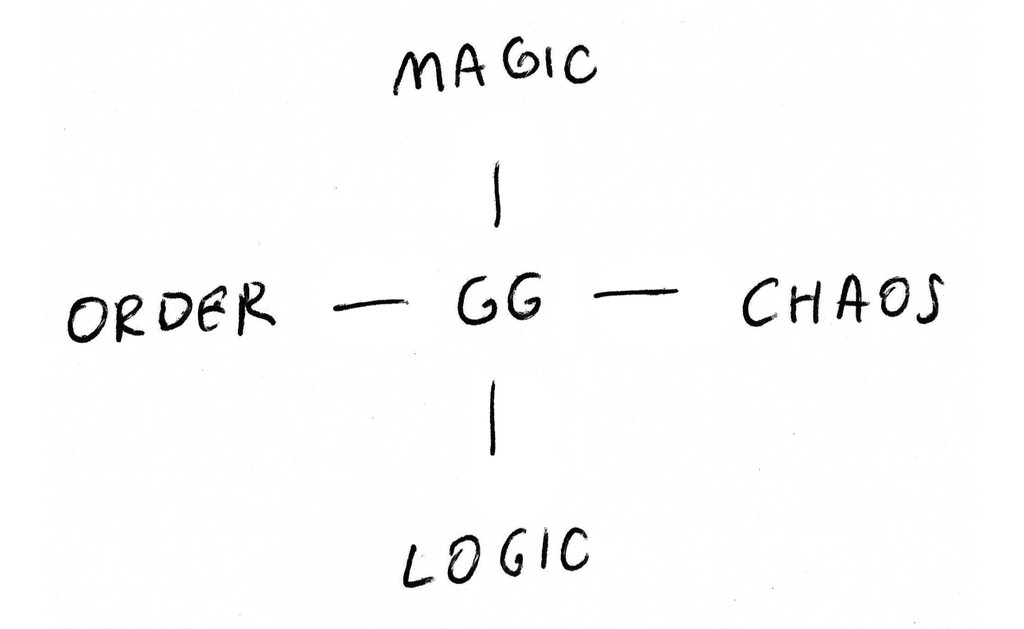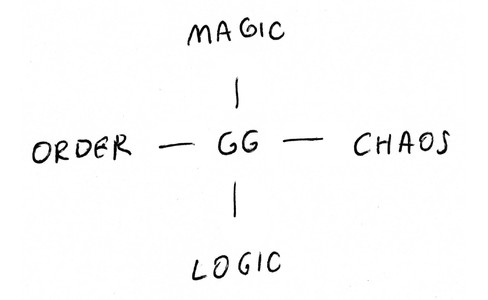Could you please introduce yourselves?
I’m Giacomo, one of the three co-founders and partners of Giga, where I serve as CEO. My background is in design, but as we grew the company, I expanded my expertise beyond the creative field. Today, my role is primarily focused on the strategic direction and management of the studio, ensuring its growth and efficiency rather than directly overseeing individual projects.
GD
I’m Gabriele, creative director of the studio. I take care of everything related to the projects on the creative, strategic and design side, I also lead research and handle all the communication of the studio with Giacomo. We have a third partner, who is not here today, Pablo Galbusera, he’s the one who leads our technology department.
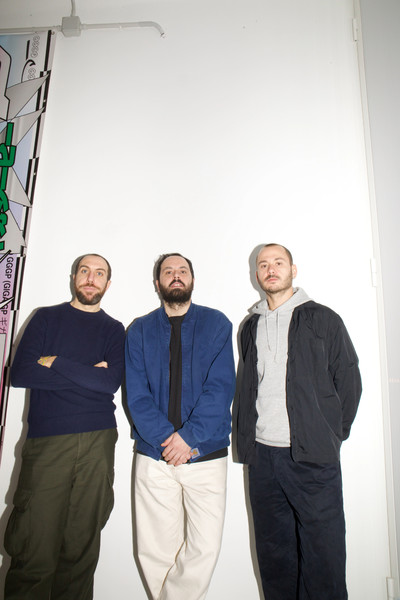

The three founders of Giga Design Studio
How do you present Giga’s activities nowadays?
We are a creative business with a strong focus on communication design. At the core of our practice lies the fusion of design and technology, which we leverage to craft compelling narratives. Looking back, we’ve realized that what truly makes us recognizable is our strategic approach and the way we develop concepts and storytelling across all our projects.
GD
The idea is to follow the whole process. From understanding the direction with the client, to taking the project through to the end to handle the details. In this way we ensure that the project doesn’t steer into something completely different without us knowing. It’s a more curated process.
GS
Of course, we love beautiful aesthetics, but our starting point is to make the project functional. We also do a lot of research inside the studio: 30% of our time is spent doing research and experimentation with new aesthetics and technologies. We hope that our projects will clearly showcase this aspect of our practice.
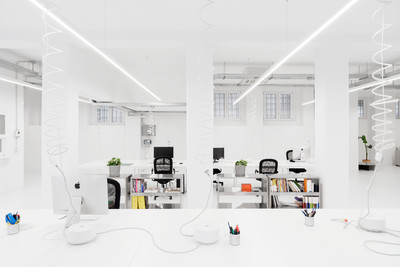
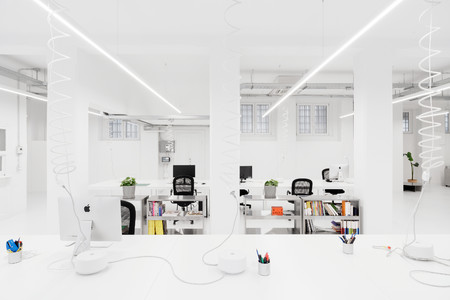
Giga Design Studio’s offices
What’s your current state of mind?
Tomorrow night Giga will turn 8 years old. We’ve gone through different phases, but it feels like a fresh start.
GS
Just a few days ago, we took the time to reflect on our journey and identified three distinct phases in our evolution.
The first phase was the first three years—when we were just three friends passionate about creating, working without constraints, and fully immersed in what we loved, without yet knowing how to run a business.
Then came a second phase, where we transitioned into a structured company, collaborating with a growing number of people and taking on larger projects. We focused on expanding and making the most of the many resources available within the studio.
Now, we believe we’ve entered a third phase—one of greater awareness of all aspects of the business: commercial, financial, and administrative. We are applying our design-driven mindset not just to our projects, but also to the entire ecosystem of the company. Today, we have a more comprehensive understanding of our business and its processes.
If you go back to when you were a student, what got you into graphic design?
When I was young, I was drawing a lot, and in middle school had fun making fanzines —without knowing the term fanzine obviously. I loved to use Microsoft Publisher to do layouts or by just drawing the content on paper. I also made some websites with FrontPage. But back then I wasn’t aware of what design was, I picked it up after high school because a friend told me about it. So I came to Milan, and it opened up all these possibilities. I rediscovered what I liked without having a clear idea from the beginning.
GS
When I started university, I didn’t have a clear path—just the sense that I wanted to work in a creative field. I began studying Product Design at Politecnico di Milano, but quickly became drawn to the communication side: how to visually explain products and services.
That interest led me to my first experience at Graphx, the graphic design division of Lissoni Associati—the studio founded by renowned Milan-based architect Piero Lissoni—where I met Fabio Frattini. He became a true mentor, introducing me to the depth of visual culture and teaching me how to navigate both the craft and the business of design. His guidance was instrumental in shaping my perspective and, ultimately, in making me fall in love with this profession.
After Fabio, a pivotal encounter in my journey was with Sergio Menichelli during my time at Studio FM Milano. That period had a profound impact on me: Sergio’s approach and sensitivity deeply influenced my visual culture and sparked a lasting curiosity in the way I observe and interpret things. It taught me to look beyond the surface, to value details, and to cultivate a more critical and nuanced design sensibility.
Then I met Gabriele, and my perspective on graphic design expanded even further by integrating it with technology, since he also codes. So we started doing things together.
Visual identity for 25AV, a platform for audiovisual arts and performance.
What was your intuition when you co-founded Giga, eight years ago? And Giacomo, you became CEO, organizer, administrator, so you design less. Was it something you anticipated?
We were working in different design studios, me and Giacomo. Alongside we also had Raumplan, a collective founded with some friends. Pablo was freelancing with both of us.
I had already moved towards the digital side of design because I love code and the possibilities it offers to build something from scratch.
At some point, I became a bit disillusioned — despite having this strong interest and passion for technology, I saw there was no interest in building a team around me. So I started to think of leaving. I was attracted to tech and startups on one side, but I was also looking to work without bosses. That’s when the idea of opening our own studio began to take shape.
GS
We were lucky that our vision matched a big change in the market. At the time, we didn’t fully realize how strong the mix of design and technology could be. Over time, we saw a gap in the Italian market, and even now, there aren’t many competitors combining both, also because many design studios outsource the technology side.
As a studio, and also as individuals, we are constantly evolving, changing the way we see things. For example, at the beginning, I was still working as a designer, but at a certain point, we realized that having two partners managing the same area would be challenging. Gabriele was also a much better designer than me, and I recognized that my strengths lay more in overseeing the overall process and organization. So, I shifted my focus.
That said, I still engage in design—just in a different way. Over time, I’ve learned that about 30% of the creative process is actually about translating the client’s needs into a clear brief. When I speak with a client, I always start with a pre-assessment to guide the project based on timing, budget, and objectives.
ASCII visual language for the website of cc-tapis, a rug making company from Milan.
When you were studying, what were your creative references and inspiration?
I played in some hardcore punk bands when I was moving to Milan, and when I got here I met people who were into completely different stuff. None of my friends at university really liked that kind of music. It actually opened me up to new worlds. Those same people inspired me a lot. We shared a big flat where we were screenprinting, doing carpentry, night drawing, coding, skating and much more. On my side I brought music and the visual communication related to it as something to share within our circle.
GS
Video games are also a big part of our background. We have this nerdy approach, and gaming has always been part of our culture. It’s not unusual for us to spend evenings in the studio exploring collaborative games and experimenting with new tools together.
GD
We had a period at the beginning of the studio where we were having Minecraft after work. When we play multiplayer games online, we are always on the same team going up against others.
Since you graduated and worked for 8 years together, have there been any new references who’ve popped up?
When we started the studio, I was a lot into digital products, had just worked three years in a branding and strategy agency, but I also had lots of interest in design. A few years before I was going to Germany to do workshops at the HfG in Offenbach, where Eike König and his class were organizing the After School Club with designers like OK-RM, Marc Kremers, Moniker and Mirko Borsche among others. I was also doing a lot of illustrations and so called creative coding, I had a project called Superinternet with our friend Pietro.
Basically we were trying to mix all these different languages together in a very chaotic way. Now, I think we reached a point where our creativity is well matched with our business. My focus is now split between learning how to lead a team and exploring artistic practices.
GS
I don’t have much time to look for new references, and over time, my focus has shifted to different aspects of design. I no longer judge a creative practice just by whether I like it or not. Instead, I consider factors like financial sustainability, project management, work quality, scalability, team dynamics, long-term impact, and how efficiently a project is executed.
At the same time, I’m still new to this side of the business, so I’m learning a lot. Managing people is the hardest part, but the biggest challenge is figuring out how to make processes more efficient without losing quality. I’m especially interested in reducing repetitive tasks to free up more time for thinking, designing, and innovating. Research is at the core of our work.
Now do you have strategic references or books that help you?
I once read A Sense of Direction by William Ball. It‘s a director discussing his approach with actors. I found his method particularly interesting — stepping back to let the actors take charge, intervening only minimally and with great sensitivity. This approach resonated deeply with me. But reality is a much different story, there’s no right formula.
GS
I don’t have a specific reference, but in terms of vision and approach, I recently read about Yvon Chouinard’s journey, which was truly enlightening in some ways. Another interesting book I read recently is Surrounded by Idiots, which explores different personality types and how to approach them.
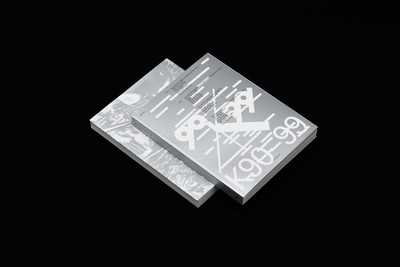

Catalogue for K90-99, an exhibition by L.U.P.O.
You mentioned that what makes you different now - at least on the Italian market in the creative industry - is your desire to integrate strategy right from the beginning. How did that happen?
The first intuition about this, as well as the idea of combining design and technology, came from Gabriele. When we started the business, my background in a studio was purely focused on graphic design. But he came from a studio that had a stronger design thinking approach and emphasized debriefing what the client really wants.
At first, this way of working felt a bit unfamiliar to me, but over time, I came to understand how important that part of the process is. Building on his intuition, I developed and refined this approach further—and it’s still a key part of how we work today.
GD
I was lucky enough to have worked with Francesco Cavalli, whom I consider one of my mentors. He taught me how to combine design with strategy. This point of view helped me a lot to open up to new perspectives, to be less focused on aesthetics and more on being collaborative. To be able to dissect a brief, rationalize my ideas and vision and to present it in a way that makes sense and is understandable. I brought this to Giga and then Giacomo mastered it much better than I did.
How do you decide on that strategy? Is it the three of you or do you have external help?
We manage the strategy internally, and our roles are highly complementary. I handle the overall strategy, focusing on business sustainability and project viability, while Gabriele is more focused on branding strategy and the creative direction. Pablo takes care of the digital strategy, selecting the right technologies and software to ensure scalability for each project.
I lead the strategic part initially because I’m the closest to the client at the beginning of the process. However, strategy is present in every phase of our work. Since we like to be efficient, we always make sure we’re taking the right approach before moving forward. We believe in integrating strategy, design, and technology to create impactful solutions.
That said, there’s one area we don’t handle: marketing. We dislike working with numbers, as we see marketing as a constant compromise between metrics and brand awareness. Our focus is primarily on building and strengthening a brand’s presence. However, we enjoy collaborating with experts who specialize in marketing, as it’s not something we manage internally.
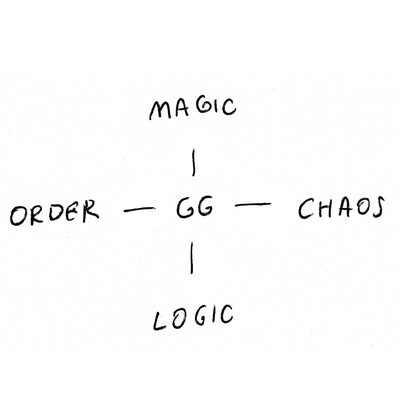
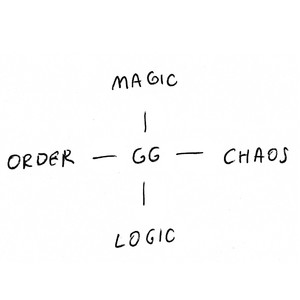
Sketch by Giga Design Studio
After eight years, what do you consider essential in terms of your future strategic development for Giga, and personally as well?
In this new phase of our studio’s evolution, our focus shifts from chasing business growth to embracing creative exploration. Each year, we start with the pressure of generating enough revenue to cover salaries and overhead. However, after eight years, we’ve built a robust foundation that now allows us to dedicate time to research and projects where we have full creative control.
At this point, we feel a strong need to express ourselves more deeply—to become authors of our work rather than just consultants. We aim to undertake projects that enable us to shape the narrative as much as the design. Currently, we’re most excited about physical installations, where we can seamlessly blend the physical and digital realms, merging design and technology to create truly immersive experiences.
GD
The main focus we have now for the studio is both teamwork and research.
We must work smart in a way that allows everyone to grow and learn more. What we are doing is teaching as much as possible to our team so they can take on responsibilities and be more empowered to make choices on their own.
On the other side we’re pushing our experimental approach to be one of our main strengths. We’ve done a lot of experiments in the past, now we want this to become something we can communicate properly and integrate in our daily practice.
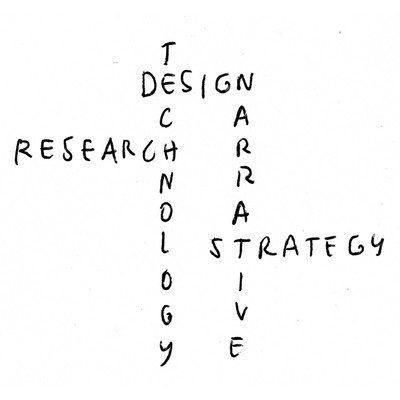

Sketch by Giga Design Studio
How do you think you can handle this?
I think it’s a slow process but what is interesting is that we have three different points of view on what we are doing. We can work on different layers to build the trust we want from our collaborators, from the clients and from our public.
GS
Basically, I push everybody every day to try new things. Now, we are more conscious and we discuss together the two or three key areas to focus on. We experiment in those areas, and if we see results, we move forward. My daily struggle, however, is spending most of my time convincing clients to invest in something I believe they need. Sometimes I’d like to completely change this—creating things that people genuinely want and naturally choose to buy.
GD
We could say it’s about balancing authorship and collaborativeness.
ASMR Rooms, a digital experience and campaign for the launch of Fornasetti Profumi
A still from the launch campaign of Fornasetti Profumi
Do you want to remain independent or do you think, at some stage, you could be open to be part of a group?
In the past, a few groups have approached us to explore collaboration or new opportunities. For now, we’re happy where we are and haven’t actively pursued that path. However, we’re always curious and open to discussions. If someone presented a truly compelling offer or opportunity, we’d certainly consider it. Looking ahead, it might make sense to explore something different at some point. This line of work is incredibly rewarding, but it’s natural to want to evolve and try new things. Personally, I can see myself wanting to branch out eventually, and I believe Gabriele and Pablo share similar feelings. I don’t see myself doing the exact same job for 50 years. At some point, it could make sense to bring in another partner or explore an entirely new direction.
GD
… to pass the torch somehow to other people! However, we are not actively looking for someone to buy us. We love what we do, and we want to keep doing it. I completely agree with Giacomo on this. But of course, we might get bored at some point.
GS
I’d like to work with someone who can help manage the bureaucracy and administrative tasks—in Italy, it’s a real mess! While we’re not actively seeking an agent, we’re always open to hearing what opportunities might arise.
How do you handle the business development part of your work?
We have some advisors to assist with that area. We also have a strong network of friends working in the field, and in the past, they’ve helped us develop a clearer midterm vision. Currently, we have a three-year plan in place. Our main goal is to establish an R&D department with the aim of eventually bringing digital products to market. This would ideally provide us with a source of passive income. But our primary focus remains on the consultancy side: evolving, taking on larger projects, attracting more high-profile clients, and becoming better known for the strategic aspects of our work rather than just the operational side. At the same time, we’re exploring the development of products that could generate passive income like digital products or even services, for example, to automate repetitive tasks.
What is your approach to pitches and competition contexts?
We try to avoid unpaid competitions. However, there are some exceptions, especially for prestigious institutions or opportunities. Since founding the company, we’ve participated in around 10 competitions in total.
GD
We’ve always approached competitions and pitches carefully because they often require significant work upfront and clients expect a final output right away.
From the beginning, we’ve taken a different approach, leveraging strategy to guide us. Instead of immediately presenting solutions, we’ve focused on asking the right questions and understanding the context. While this approach hasn’t always worked, it has helped us win the pitches that mattered the most. It also reinforced an important realization: we don’t want to participate in too many competitions. We’re not willing to give away our time - or, more importantly, the time of our team - for free, especially when the expectation is to generate ideas without proper compensation.
GS
Regarding clients, I think it’s quite straightforward. I would say that 50% come from our network and 50% from our portfolio. We never do prospection, it’s always the clients who have contacted us. In that sense, we’ve been quite lucky, and it allows us to choose the clients we work with because we have many requests.
How do you decide to say no to some clients or some projects?
Now that we’ve done more strategic work on ourselves, we’re more focused in that area. Essentially, we say no if the client isn’t relevant to us in terms of their industry because we focus on art, fashion, and design. For example, if a client from an engineering company approaches us, it’s not something that’s strictly related to our world (Of course, it depends on the request.). That said we would always listen to everyone and then evaluate based on economic relevance, strategic alignment, and our available capacity.

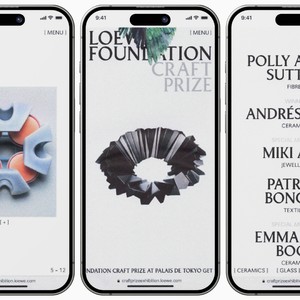
Work for the The Loewe Foundation annual Craft Prize
How do you handle your communication?
I’m getting better. Luckily, Giacomo pushes me to be more organized at it, because I tend to be a bit chaotic in my process. But essentially, it’s about gathering as much as possible from what we do and presenting it in the best way possible. Sometimes it’s in a very rough way, other times it’s more polished, other times we really go into details.
GS
For me, Gabriele is one of the best designers I’ve ever met, and that’s evident in our website. Even though it has been live for five or six years, it still feels fresh, and we continue to see other studios drawing inspiration from it. To me, it’s timeless.
That said, we are now starting a rebranding process. We want to explore new themes and push fresh aesthetics for the coming year.
The three of you are mentioned as the founders, but there’s little physical incarnation of the studio. Is that a conscious decision as well?
First of all, we are a bit shy, we’re not super confident in some areas, so that’s definitely part of it. The other thing is that we have always valued the collaboration between us and talked about Giga as a whole. However, we are now trying to find a balance between these two approaches for the future. On one hand, I think it is very important to maintain this mindset because it also gives space to people who come into the studio, beyond just the three of us. On the other hand, we’re also working on overcoming our shyness. As we get older, it’s important for us to focus on our personas, not just our work, but also how we are perceived in Milan, in the world, and within the industry we work in.
GS
We approach this with intellectual honesty, letting our projects speak for themselves. However, when we’re invited for interviews or asked to share our work, we’re happy to talk about our approach and practice.
That said, we’re adjusting this mindset because it’s becoming an important part of our business strategy. For example, if I want to launch a product, I need to engage with venture capitalists or private equity funds—and they need to know who I am. After all, people invest in people, not just ideas. That’s why we’re working on presenting the studio in a more human way, highlighting the team behind Giga and the people who make it all happen.
Digital platform for MASSIMODECARLO, an art gallery founded in 1987
Your Linktree offers a whole environment, like a curated newsletter: how do you conceptualize it and what are the next steps?
Up until now, we’ve approached things in a somewhat chaotic way but we’re now trying to understand the purpose behind each item and define clear goals for each of them. For example, the newsletter is very important because it allows us to explain our practice in more detail, but it’s mainly targeted at the creative community. The Instagram account has become a platform where we share the most effective content about our research approach. We do a lot of experiments and produce a large amount of content, so we thought it might be interesting to share that, alongside the projects we do for our clients.
How big is Giga at the moment? How many people are working at the studio now?
We are 20 people in total. Internally, we have 17 people, and then three collaborators who work on specific projects. We’re essentially divided into three main teams: design, technology and interaction. They actually work side by side. The design department itself is further split into two teams. A visual team, more focused on branding, visual identities and graphic design, and a digital team, more focused on websites, interfaces and generally UX/UI design. The technology department is focused on web technologies while the interaction one is focused on the intersection of emergent media, spatial design and immersive installations. In terms of structure, we also have a Project Manager who coordinates the entire team. This person acts as a filter between us and the rest of the team. Additionally, we have an administration team composed of two people.
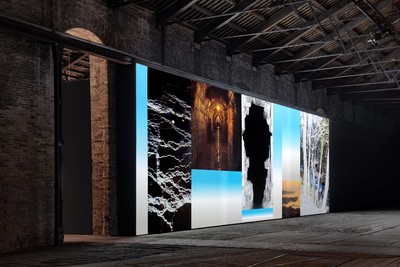
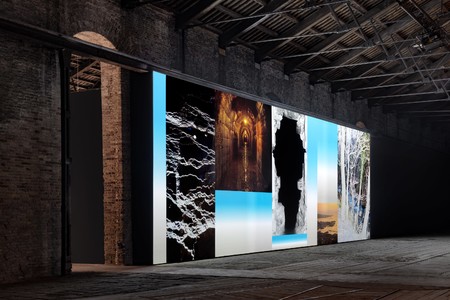
Spaziale, Italian Pavilion for the 2023 Venice Architecture Biennale, curated by Fosbury Architecture

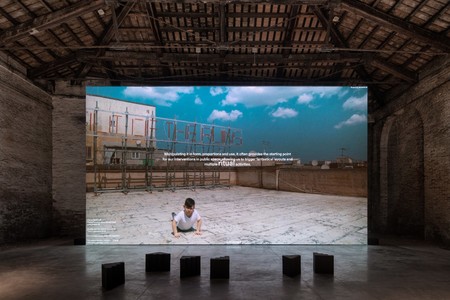
Spaziale, Italian Pavilion for the 2023 Venice Architecture Biennale, curated by Fosbury Architecture
How did you develop a management approach or style?
We didn’t study for this—we learned by doing. Now, I’ve started studying management a bit to gather ideas and adapt them to our studio, but for the most part, we are continuously learning and evolving through experience. Our goal is to develop our own culture and refine our vision of the business.
What would be your ideal size?
For now, 20 is the ideal size because it allows us to maintain the quality we want. It enables us to distribute workloads effectively while ensuring steady growth. We could expand slightly, but I don’t think going beyond 25 would be wise, as it could make it harder to maintain control.
How do you see the current creative market overall, in Italy and around the world? What are the trends and the perspective?
We try to position ourselves between niche and mainstream, especially in our approach to technology. Our goal is always to simplify the complex, making technology more accessible for our clients and users while integrating it seamlessly into visual and design-driven experiences.
GD
I think it’s all about balance between strengthening one’s own vision and being open to what is happening in the world that is bigger than us.
When we started we needed to make money to be financially sustainable, now we want to focus on selling our vision.
Anyway, we have high standards for what we do, we always aim at doing something that is truly helpful for our public, but also clearly understood by the client. We want expectations and reality to align as closely as possible.
Rebranding and visual identity of Pinacoteca Agnelli
How do you see the perspectives in terms of artificial intelligence?
We’re currently experimenting a lot with AI. But we don’t fear that AI will replace our work. We believe that behind AI, there still needs to be a designer to guide it toward the desired outcome. We see AI more as a tool that helps us in the process and gives us more time to think and refine our ideas. Of course, in terms of research and aesthetics, it’s a completely different approach.
GD
We try to experiment with anything that comes our way.
Every technology that we can test, we give it a go. We have even experimented with blockchain in the past. Right now, apart from AI being such a buzzword and generating a lot of noise, we can actually see its potential, we already use it a lot every day.
Since we have a strong understanding of technology, we can approach it from both a technical and creative perspective. We have so many opportunities for exploration and experimentation.
The annual campaign and visual identity of P:S Creative Agency at Milan Design Week 2025
Among the younger talents you are working with, what are the evolutions you are observing?
One thing I’ve noticed is that in the design field there seems to be less interest in systems and more focus on image making. This makes sense, given that we’re constantly surrounded by images and instant communication.
On the other hand, I am very much into systems. When I create a visual identity, I think of it as a set of rules or a framework to build upon, just like when I’m actually coding. Many of my students for example are focused on single images, which I also love, but it’s a different approach. It’s also a very different process.
That’s one major thing I’ve noticed, however I am not entirely sure if that observation is accurate. We teach a lot in schools, so we can see a wide variety of approaches, people seem to find their own way into this field in very different ways.
How important is teaching for you?
I have been teaching at the Politecnico di Milano for eight years now. For me, teaching is crucial because I learn a lot from it. I don’t have much time during the day, so I don’t do a lot of research or stay updated in the same way others might. Teaching and interacting with young people for eight hours a week helps me stay current and involved in what’s happening in the world, not just in terms of visual references or design projects, but also in terms of slang, trends, memes, and all that.
GD
I teach in different schools and in different ways. I think I fit better in workshops and short courses. I love working with people who are still in the process of discovering themselves, not yet fully aware of what they’re doing, and still very open to exploring many different possibilities.
GS
It is also very important for the business, as many of our team members are former students. Spending an entire semester with them allows us to assess not only their technical skills but also their attitude and ability to integrate into the studio.
We don’t rely on recruitment agencies since past experiences haven’t worked out well for us. While we receive about 10 design applications per week, hiring a developer who truly fits our team is far more challenging. Many developers prefer full remote work, and although we’re open to it, we highly value the time spent together discussing ideas and designing collaboratively as a team.
Are there any other potential evolutions or developments you sometimes think about?
We have also talked about expanding to the US at some point. But we want to see how our work evolves. If we start receiving more interest from outside, which is actually happening now, then maybe we will seize the opportunity. If things keep improving, we will definitely take advantage of those opportunities.
GS
We are not the kind of studio that aggressively pushes in a specific direction. Instead, we prefer to be open to opportunities. If something comes up, we’re always eager to understand it better and evaluate whether it could be a good fit for us. Right now, for example, there is an opportunity for a mid-term project in Asia, which is exciting. If it works out, we will pursue it. But it is not about us relocating to another country. A couple of years ago, we had a client in Saudi Arabia, and they suggested we open a studio there. But in the end, we listened to everyone and focused on seizing the right opportunities as they came.
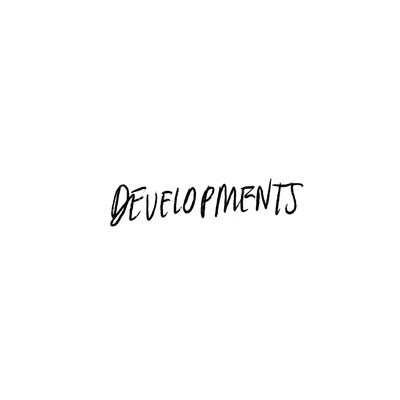
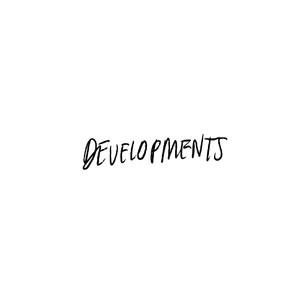
Sketch by Giga Design Studio
If you could do another job or live at another time in history, what would it be and when?
More than a different time in history, I’d choose a different way of living. I’d love a job that keeps me connected to nature and respects a more natural rhythm of time. The idea of being outdoors, creating something tangible, and stepping away from the constant rush of modern life is really appealing. It’s not just about the job itself, but about embracing a different lifestyle.
GD
One thing I sometimes wonder about is making just one thing. Basically the opposite of what I do now. I don’t want to do it now, but that is something that I would really like to try.
Are there books which have helped you? Personally, business-related or philosophically?
I do read some essays, but I get more inspired by novels. The good thing about books for me is that they take up my time, and I really start wandering with my thoughts. I have many writers I love, it’s difficult to name one. Sometimes I read science or philosophy related books, but I always prefer them in the form of novels. Some books I recently read and loved are La Peste by Albert Camus, Helgoland by Carlo Rovelli and Paradise Rot by Jenny Hval.
GS
I’m not a great reader. I’m the type of person who buys thousands of books, reads a few pages, and then moves on to the next one. I don’t really have a clear reference or a specific book that stands out. I used to worry about this because I enjoy being around people who can dive deep into a subject. But I’ve realized over time that I’m more of a person who needs to know a little about a lot of things, rather than going deep into few topics. I’m more transversal, exploring many different perspectives. I like to approach every subject from multiple points of view, not just one.
Are there some artists or another person who have really influenced you or who have really helped you along the way?
The people I’ve met in my life are more important than my visual references or the artists I admire. I’m very happy to have found two people in my professional life who have truly helped me become who I am today. So, there’s no competition between the two things.
GD
For me as well, both here at work and also during my university years, I found people who really inspired me a lot. Friends who are still friends, people I see much less now because they’ve moved away from Milan. The people with whom I had a connection have inspired me much more than famous artists or well-known figures that I don’t personally know.
If you had to give one piece of advice to young creative talent starting a studio nowadays, what would it be?
For me, once you understand that design is only 20% of the job, you become a better designer.
GD
For me, it’s about staying open to what’s happening around you. It’s important to remain receptive to what you can learn, because there’s a lot of interesting things out there.


Sketch by Giga Design Studio
